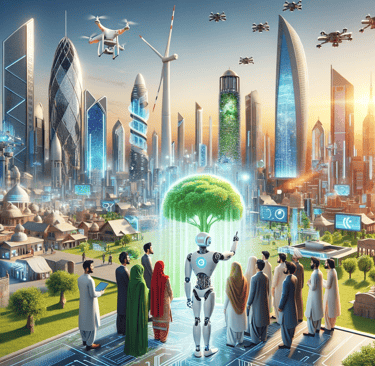AI in Developing Countries: Bridging the Digital Divide
Artificial Intelligence (AI) is revolutionizing the world, but its impact is not evenly distributed. While developed nations surge ahead, developing countries grapple with unique challenges. In this article, we explore how AI is being harnessed in these regions, the hurdles they face, and the promise of a more equitable future.
Faheem Hassan
1/14/20242 min read


AI is much more than a buzzword; it’s a transformative force. From facial recognition to spam filters, AI permeates our lives. However, the digital divide between developed and developing countries persists. While nations like the US, Singapore, and the UK lead the AI race, many regions in Africa, the Caribbean, and Latin America lag. Urgent priorities like education, healthcare, and food security often overshadow investments in digital transformation.
In this context, we delve into the challenges and opportunities of AI adoption in developing countries. We discuss how AI can bridge gaps, empower communities, and drive sustainable growth. Let’s explore the hidden costs, the role of machine learning and deep learning, and real-world applications that can transform lives.
The Hidden Costs of Modern AI
AI, defined as “the science and engineering of making intelligent machines,” holds immense promise. But it comes with hidden costs. Developing countries must balance urgent needs with long-term investments. While wealthier nations pour resources into AI research, others grapple with necessities. The risk? A widening digital divide.
Machine Learning vs. Deep Learning
AI encompasses two main areas: machine learning and deep learning. Machine learning thrives on well-organized data, while deep learning tackles complex real-world problems. For instance, deep neural networks analyze chest X-rays to predict respiratory diseases. Understanding these distinctions is crucial for effective AI implementation.
AI Applications with Impact
Healthcare: AI aids diagnosis, drug discovery, and telemedicine. In Rwanda, drones deliver medical supplies to remote areas, saving lives.
Agriculture: AI predicts crop yields, monitors soil health, and optimizes irrigation. India’s “SmartAgri” initiative empowers farmers with data-driven insights.
Energy: AI enhances grid management, renewable energy integration, and energy efficiency. Ghana’s “Smart Grid” project exemplifies this.
Financial Services: AI-driven microloans, fraud detection, and mobile banking empower underserved populations. Kenya’s M-Pesa revolutionized mobile money transfers.
Challenges Ahead
Data Quality: Developing countries often lack high-quality data. AI models thrive on robust datasets, posing a hurdle.
Capacity Building: Training AI professionals and fostering local expertise are essential.
Ethics and Bias: Ensuring fairness and transparency in AI algorithms is critical.
A Brighter Future
AI can be a catalyst for change. Developing countries can leapfrog into a tech-enabled future by prioritizing inclusive AI policies, investing in education, and fostering collaboration. Let’s ensure that AI serves all, leaving no one behind.
